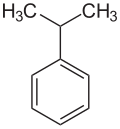The C3-benzenes are a class of organic aromatic compounds which contain a benzene ring and three other carbon atoms. For the hydrocarbons with no further unsaturation, there are four isomers. The chemical formula for all the saturated isomers is C9H12.
Contents
There are three trimethylbenzenes, three ethylmethylbenzenes, and two propylbenzene isomers. 1980s American gasoline contained about 3-4% C3-benzenes. [1]
- 1,2,3-trimethylbenzene or Hemellitene
- 1,2,4-Trimethylbenzene or Pseudocumene
- 1,3,5-Trimethylbenzene or Mesitylene
- 1,2-Ethylmethylbenzene
- 1,3-Ethylmethylbenzene
- 1,4-Ethylmethylbenzene








